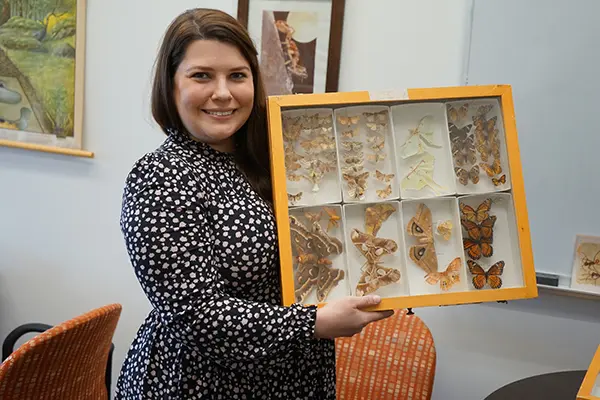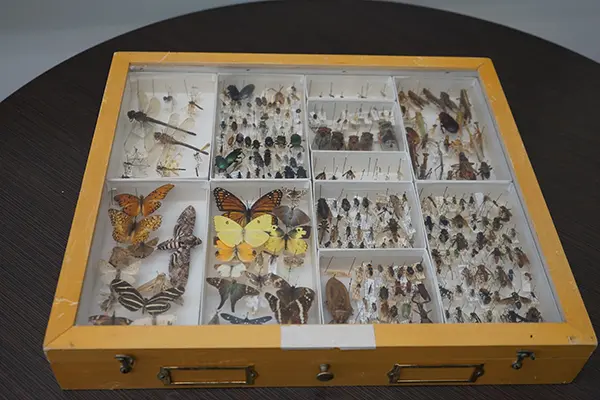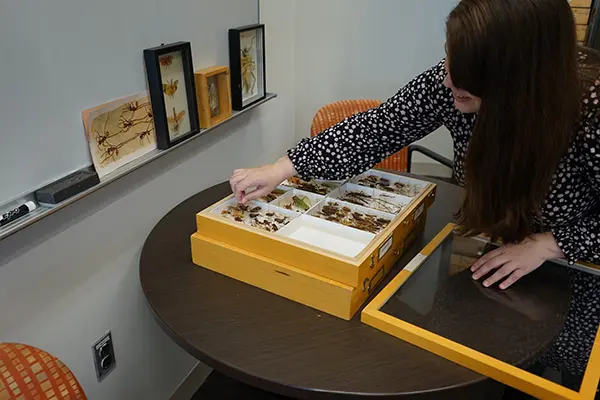Asst. Prof. Christina Kwapich Uses Collection to Teach Entomology
 Image by Brooke Coupal
Image by Brooke Coupal
05/19/2022
By Brooke Coupal
Thousands of preserved bug specimens from around the world have made their way to UMass Lowell to help enhance the study of insects.
Biological Sciences Asst. Prof. Christina Kwapich is the new curator of roughly 15,000 insects previously kept at Florida State University. Some of the insects date back to the 1800s and are pinned inside about 30 wooden boxes located in Kwapich’s office at Olsen Hall.
“These collections are really priceless because they can tell us about biodiversity from hundreds of years ago,” she says.
Kwapich sought out this collection after designing a new entomology course when she arrived at UMass Lowell. She taught her first entomology class last fall with her own personal collection of about 2,000 insects, in addition to loaner insects from UMass Amherst and UMass Boston, but felt it was important to expand the collection at UML so that interested students could learn more about insect diversity.
She heard from her former Ph.D. advisor at FSU, Emeritus Professor Walter Tschinkel, that no one had been taking care of FSU’s insect collection since he retired. Given her interest in the specimens, Tschinkel reached out to FSU Biological Science Chair Thomas Houpt, who Kwapich says was “more than willing” to allow her to become the curator of the collection. From there, the insects were carefully transported from Tallahassee, Florida, to Lowell, Massachusetts.
“This is going to make the class on par with our peer institutions that have natural history museums and big biological collections,” says Kwapich.
The specimens will be available to students for analysis as they gather insects for their own collections. Equipped with butterfly nets and jars, Kwapich took her students on local field trips last fall to find insects that they then learned to curate and categorize.
“A student in the class caught something very unusual in the fall — a mantispid, which is a type of neuropteran insect that sort of looks like a praying mantis and a lacewing combined,” says Kwapich. “It has raptorial four legs that will reach out to grab prey, but it also mimics a wasp, so it has black and yellow stripes.”
 Image by Brooke Coupal
Image by Brooke Coupal
“What I’m fighting against is actually other bugs that will come and destroy the collection,” says Kwapich, who looks closely for dermestids, a type of beetle that targets dead insects. “It’s almost like revenge.”
Piles of dust are a telltale sign that the specimens are being eaten. Kwapich will vacuum away this dust in addition to freezing the insects. She also looks for mold or moisture because it’s important to keep the collection dry.
“It takes constant maintenance to keep an eye on the collection,” she says. “Insects, because their cuticle is made of chitin, which is a really strong material, can essentially last as long as they’re not destroyed by outside forces.”
There is much to be learned from entomology, with about 900,000 different known kinds of living insects, according to the Smithsonian Institution. Some experts estimate that this figure could actually be as high as 30 million.
“If we went to Mars or another planet and we discovered a group of organisms living there, they couldn’t be any more interesting than the insects we have on Earth,” says Kwapich. “They’re so diverse and different that they’re like little aliens.”
 Image by Brooke Coupal
Image by Brooke Coupal
“People are always looking for experts, because there are so many intersections of humans and insects,” she says. “They’re just one of the most important animal groups on the planet.”
One career path that Kwapich says surprises students is that they can work for the Army as an entomologist to study sandflies and other types of insects that affect troops overseas.
Entomologists are vital in investigating disease outbreaks caused by insects, such as the mosquito-borne Zika virus. Some of them focus on controlling the population of infected insects by releasing sterile males or genetically modified insects into the environment.
“That takes really intimate knowledge of the lifecycle and life history of these insects, so you really need an entomologist to be able to correctly identify the insect and know everything about its physiology and toxicology of how you control it,” says Kwapich.
Others, like Kwapich, who specializes in ants, are interested in studying insect behavior such as their parental care and how they socialize.
“You can either be a friend to insects if you become an entomologist, or you try and control them for our own sake,” she says. “So, entomology opens up some nice opportunities. There are lots of jobs.”
